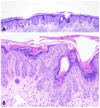Galli-Galli Disease: A Comprehensive Literature Review
- PMID: 38390850
- PMCID: PMC10885078
- DOI: 10.3390/dermatopathology11010008
Galli-Galli Disease: A Comprehensive Literature Review
Abstract
Galli-Galli disease (GGD) is a rare genodermatosis that exhibits autosomal dominant inheritance with variable penetrance. GGD typically manifests with erythematous macules, papules, and reticulate hyperpigmentation in flexural areas. A distinct atypical variant exists, which features brown macules predominantly on the trunk, lower limbs, and extremities, with a notable absence of the hallmark reticulated hyperpigmentation in flexural areas. This review includes a detailed literature search and examines cases since GGD's first description in 1982. It aims to synthesize the current knowledge on GGD, covering its etiology, clinical presentation, histopathology, diagnosis, and treatment. A significant aspect of this review is the exploration of the genetic, histopathological, and clinical parallels between GGD and Dowling-Degos disease (DDD), which is another rare autosomal dominant genodermatosis, particularly focusing on their shared mutations in the KRT5 and POGLUT1 genes. This supports the hypothesis that GGD and DDD may be different phenotypic expressions of the same pathological condition, although they have traditionally been recognized as separate entities, with suprabasal acantholysis being a distinctive feature of GGD. Lastly, this review discusses the existing treatment approaches, underscoring the absence of established guidelines and the limited effectiveness of various treatments.
Keywords: acantholysis; genetic; hyperpigmentation; keratin-5; papulosquamous; skin diseases.
Conflict of interest statement
The authors declare no conflicts of interest.
Figures






References
-
- Bardach H., Gebhart W., Luger T. Genodermatose bei einem Brüderpaar: Morbus Dowling-Degos, Grover, Darier, Hailey-Hailey oder Galli-Galli? [Genodermatosis in a pair of brothers: Dowling-Degos, Grover, Darier, Hailey-Hailey or Galli-Galli disease?] Hautarzt. 1982;33:378–383. - PubMed
Publication types
LinkOut - more resources
Full Text Sources
Research Materials
Miscellaneous

